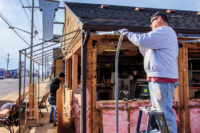The Super Bright Future of Restoration Contracting








Climate change, the politically correct term for “global warming,” is upon us and no matter what side of the fence you sit on regarding its causes and solutions, one thing is certain - it is going to be really good for the restoration business.
If you’re in the restoration business, you can look forward to decades of increasing demand for your services at increasing rates of growth. There are three primary reasons for this:
- Global warming creates more extreme weather (i.e., hotter hots, colder colds, wetter wets and dryer dries) which translates to more broken pipes, wild fires and floods, all of which will be very good for the businesses that repair the damages from weather events.
- Buildings have been and continue to be built without enough attention to the permeability of the exterior envelops. Basically the walls do not breathe enough to prevent mold growth after extreme weather events. That fact, combined with changing weather patterns, means more buildings will need mold remediation in the future. One of the leading authorities in the building science discipline, Dr. Joe Lstiburek, predicted that mold remediators would be fully employed by failed building designs and construction defects for generations to come about 8 years ago at a restoration industry conference.
- Government subsidized property insurance policies on high-risk properties guarantee a steady source of work and funding for restoration firms.
Insurance companies also have a very bright future as a result of global warming. Due to global warming, there will be an increasing demand for insurance to cover the damages arising from the extreme weather events that the phenomenon causes.
The insurance industry runs on a very simple business model: bring more premium in the front door than the claims payments going out the back door. Insurance companies make profits on the margin between insurance premiums taken in and the claims payments going out. The more things that get paid for through insurance policies, the more profit insurance companies stand to make.
To grow, insurance companies need more claims every year. Nothing could be better for property insurance companies from a business standpoint than global warming.
The insurance companies face two major challenges in global warming:
- Getting enough money in the front door to cover the money going out the back.
- Having enough funds on hand to cover a really big loss without bankrupting the insurance company.
The insurance company strategic planners are a little freaked out by climate change today. Why? Because it is hard to predict the ultimate impact of climate change on insurance claims. To help them set premium levels, insurance companies use actuaries (highly paid mathematicians) to look at historical loss trends in order to predict what the actual claims are going to be under the insurance policies they sell.
Actuaries work on the principle that you can use mathematics to predict where you are going by seeing where you have been. That is a lot like driving a pickup truck through the fields of South Dakota by mounting a steering wheel, gas pedal and brake on the tailgate and steering the truck moving forward by looking out the back end. There are many places in South Dakota where that rear view navigational plan can work out for many miles without something bad happening. The problem is you cannot see where you are going looking back off the tailgate. Just as the pickup truck will eventually end up in a ditch, river or lake, property insurers are having problems with navigation when the premiums they charge are based on historical loss models in the face of climate change. The smart insurance companies will figure out a way to charge enough premium to cover their losses.
The CEO of Allstate Insurance Company commented a few years ago that he thought that no commercial insurance company could responsibly write property insurance in Florida due to catastrophic hurricane risks in the state. The CEO’s primary job is to produce a profit for the shareholders and to keep the insurance company solvent.
To address the problem of property insurance availability for its citizens, the state of Florida created a government insurance program to insure the high-risk properties in the state. The governor of Florida even suggested the creation of a national reinsurance program like the Flood Insurance Program to back up their state-sponsored property insurance company.
Government-sponsored property insurance schemes are an exceptionally good deal for restoration firms. Properties that are too risky to insure in the for-profit insurance business are insured by the government instead through tax subsidized insurance premiums. With government insurance programs in place, extraordinarily risky buildings remain occupied just waiting to have a loss that a restoration contractor can repair.
Government backed property insurance programs encourage really bad risk management decisions and pay for those bad decisions through taxes that are not risk-based. Take flood insurance as an example. The people that purchased flood insurance over the past 40 years have only paid about 1/3 the premiums that the Federal Flood Insurance program needed to cover the losses it had to pay. Sometimes the same properties would be repaired repeatedly over the years because the floods just keep coming. Taxpayers funded the 2/3 premium short fall through taxes that were completely unrelated to flood risk. The flood insurance tax subsidies encourage developing and redeveloping property in flood zones.
Restoration firms are double winners in global warming, more work and government subsidies. As long as tax payers living on hills in the Midwest do not object to using their tax dollars to finance property development and rebuilding in flood zones, restoration firms are going to get a nice ride from the increase in extreme weather events.
Here are some interesting predictors of where the restoration business is going as a result of climate change:
Number of global weather related catastrophes: (Source: Swiss Re Economic Research and Consulting)
|
1970 |
27 |
|
1992 |
130 |
|
2010 |
155 |
Costs of extreme weather events: (Source: Swiss Re Economic Research and Consulting)
|
1970 |
$2,000,000,000 |
|
1980 |
$1,500,000,000 |
|
1995 |
$62,000,000,000 |
|
2010 |
$155,000,000,000 |
Losses caused by thunderstorms in the U.S. (Source: Munich Re)
|
1980 |
$2,600,000,000 |
|
1995 |
$7,000,000,000 |
|
2003 |
$9,700,000,000 |
|
2011 |
$27,500,000,000 |
Looking at the thunderstorm chart, it is easy to see why the direct repair restoration networks are clamoring for roofing contractors. Insurance companies pay for an awful lot of new roofs from hail storms. Few business sectors in the economy share the growth record of new roofs resulting from insured hail damage.
Graphs showing the amount of carbon dioxide in the atmosphere track very closely to the weather events referenced above. Graphs that track the human population of the globe over time look a lot like the graphs showing the increases in carbon dioxide in the atmosphere.
A lot of people think the debate on the cause of global warming is fairly new. But global warming resulting from burning fossil fuels creating a greenhouse effect by adding carbon dioxide to the atmosphere is not a new idea. A scientist in 1890 at the University of Wisconsin was accurately forecasting what would happen to the temperature of the Earth if humans released a lot of CO2 into the atmosphere by burning coal in the industrial revolution.
Since we have known about the risks of CO2 for 125 years and did nothing about it, it is a safe bet that nothing major will change in the demand for restoration services for a generation or two.
Based on a review of 12,000 research papers on the subject of global warming, it’s at a 97% consensus now that greenhouse gasses in the atmosphere is causing global warming and the burning of fossil fuels is the cause of increasing levels of CO2 in the atmosphere. In that 3%, I read a research study that said there was no evidence over time of an increased frequency of tornados related to the levels of carbon dioxide in the air. The authors must not have had access to the insurance industry loss data on extreme storms in general.
The growth trend in the restoration business will increase now that we have record levels of CO2 in the atmosphere. We likely have already reached the tipping point with CO2 in the atmosphere. The tipping point theory says we will enter a feedback loop of even faster warming as the CO2 in the thawing permafrost is released into the atmosphere. That warming feedback loop means more restoration work in the near future and even more work in the long term.
Oh by the way, if those numbers on weather patterns concern you about the health and well-being of the earth and your grandchildren, support alternative energy sources and curbing the unbridled growth of the global human population where you can. I’m a full time environmental risk management specialist with no investment in energy stocks. As far as I can tell, humans needed to stop releasing the sequestered carbon in fossil fuels many years before Vice President Gore sounded the alarm with An Inconvenient Truth. But the real elephant in the room is the continued expansion of the human population, which is adopting increasingly western standards of living in a fossil fuel-based global economy. The Earth would need to be five times bigger than it is to sustain the current world population at the lifestyle we maintain in the U.S. That is a planet five times bigger than it is, without adding in a factor for population growth.
The current course of humans consuming finite natural resources is unsustainable. The good news is we already have the technical know how to fix the causes of global warming, we just choose not to do anything about it. The restoration industry is in for a great ride fixing the secondary effects of global warming for decades to come.
Looking for a reprint of this article?
From high-res PDFs to custom plaques, order your copy today!












